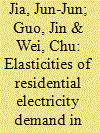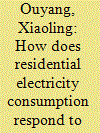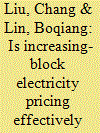|
|
|
Sort Order |
|
|
|
Items / Page
|
|
|
|
|
|
|
| Srl | Item |
| 1 |
ID:
179683


|
|
|
|
|
| Summary/Abstract |
China has implemented the residential increasing-block electricity pricing (IBEP) policy since the second half of 2012, which is considered the most effective economic instrument in improving residential energy efficiency. Price and income elasticity are two fundamental parameters to guide both scholars and policy-makers in assessing whether and to what extend Chinese households respond to the policy. However, it presents the challenge of simultaneous determination of marginal price and electricity consumption; further, it is less examined from an empirical perspective due to the absence of micro-level data. To fill this gap, this study estimates price and income elasticity by establishing two instrumental variables, based on a unique dataset from the Chinese Residential Energy Consumption Survey 2014. Results show that the residential demand for electricity is price inelastic and that electricity is an essential commodity for households in the short run. It also shows great urban-rural disparity and regional heterogeneity of household electricity consumption behavior regarding short-run income elasticity. The estimated parameters of short-run price and income elasticities provide a valuable reference for policy-making regarding both a nationwide uniform and a differential regional perspective.
|
|
|
|
|
|
|
|
|
|
|
|
|
|
|
|
| 2 |
ID:
149989


|
|
|
|
|
| Summary/Abstract |
This article describes the electricity consumption in Brazilian residences between 1985 and 2013 through linear regressions. The explanatory variables considered were the number of households, effective consumption of families as a proxy for family income, and electricity tariff for households. To deal with the power generation crisis of 2001 we have introduced a dummy variable in the form of a step function. With such explanatory variables, we were able to account for the reduction of household electricity consumption caused by the policies conducted in 2001 and their permanent consequences. The regression presented coefficient of determination of 0.9892, and the several statistic tests conducted assured the existence of long-term relation between the electricity consumption in residences and the explanatory variables. The obtained elasticities for the household consumption of electricity with respect to number of residences, family income and residential tariff of electricity were 1.534±0.095, 0.189±0.049, and −0.230±0.060, respectively. These results allowed understanding the evolution over time of the household consumption of electricity in Brazil. They suggest that the electric sector in Brazil should pursue an active policy to manage demand of residential electricity using tariffs as a means to control it.
|
|
|
|
|
|
|
|
|
|
|
|
|
|
|
|
| 3 |
ID:
187601


|
|
|
|
|
| Summary/Abstract |
Energy conservation from efficiency-oriented policies could be undermined due to the substitution effect and the income effect originating from the fact that energy efficiency improvement decreases the real price of electricity consumption. The ratio of the electricity consumption caused by the substitution effect and the income effect to the potential energy savings is termed the rebound effect. The magnitude of the rebound effect depicts how residential electricity consumption responds to electricity efficiency improvement. This paper adopts a stochastic electricity demand frontier approach based on the panel data covering 278 cities in China to uncover the relationship between electricity efficiency and residential electricity consumption. The main results show that 48.88% of the energy saving from efficiency improvement is offset due to households’ behavior adjustments. We also find that residential income, population density, and temperature deviation are vital determinants of residential electricity consumption, whereas household size significantly shapes the magnitude of the rebound effect. The empirical findings imply that different regions in China should design supporting policies for energy efficiency improvement according to local conditions considering that households are incentivized to consume more electricity with efficiency improvement.
|
|
|
|
|
|
|
|
|
|
|
|
|
|
|
|
| 4 |
ID:
171483


|
|
|
|
|
| Summary/Abstract |
China is the largest emerging economy and electricity consumer in the world. Despite the rapid increase in residential electricity consumption, retail residential electricity price in China remained at a low level, leading to large amounts of cross-subsidies. To address this issue, the increasing-block electricity pricing (IBP) system was established in the residential sector nationwide in 2012. This paper depicts the detailed implementation of the IBP in Shanghai and Shenzhen, which are typical Chinese cities. Overall, the IBP motivates residential electricity saving to some extent. However, 15.55% of the respondents still do not know about the IBP. Most respondents have limited knowledge about the contents of the IBP. 58% of the respondents were unaware that retail residential electricity prices were subsidized by the government. Furthermore, binary response models were applied to analyze the influencing factors of respondents' electricity saving feedback on the IBP. The analysis indicates that if households are large, apply time-of-use (TOU) pricing, purchase energy-efficient appliances, have adequate knowledge of electricity saving and IBP contents, or understand the situation of electricity cross-subsidy, they are more likely to be influenced by the IBP to save electricity. The government should enhance public's awareness about IBP, optimize the pricing of each block and guide the residents to understand the existence of electricity subsidy.
|
|
|
|
|
|
|
|
|
|
|
|
|
|
|
|
| 5 |
ID:
111428


|
|
|
|
|
| Publication |
2012.
|
| Summary/Abstract |
A multivariate statistical approach to lifestyle analysis of residential electricity consumption is described and illustrated. Factor analysis of selected variables from the 2005 U.S. Residential Energy Consumption Survey (RECS) identified five lifestyle factors reflecting social and behavioral patterns associated with air conditioning, laundry usage, personal computer usage, climate zone of residence, and TV use. These factors were also estimated for 2001 RECS data. Multiple regression analysis using the lifestyle factors yields solutions accounting for approximately 40% of the variance in electricity consumption for both years.
By adding the household and market characteristics of income, local electricity price and access to natural gas, variance accounted for is increased to approximately 54%. Income contributed ~1% unique variance to the models, indicating that lifestyle factors reflecting social and behavioral patterns better account for consumption differences than income. Geographic segmentation of factor scores shows distinct clusters of consumption and lifestyle factors, particularly in suburban locations. The implications for tailored policy and planning interventions are discussed in relation to lifestyle issues.
|
|
|
|
|
|
|
|
|
|
|
|
|
|
|
|
| 6 |
ID:
104954


|
|
|
|
|
| Publication |
2011.
|
| Summary/Abstract |
An econometric study of the Portuguese residential electricity consumption is presented, with a focus on the influence of dwelling characteristics on consumption. The relationship between the dwelling and household characteristics on per capita residential electricity consumption is estimated at two different scales, involving two distinct databases: the first includes data at the municipality level for 2001, the second is the most recent Portuguese consumer expenditure survey that was collected in 2005 and 2006. The results of the analysis at both scales are consistent and indicate that household and dwelling characteristics have a significant influence on residential electricity consumption. Our results show that in Portugal the direct effect of income on electricity consumption is low and becomes smaller when more relevant control variables are included in the analysis. Future demand of electricity in Portugal will be significantly influenced by trends in socioeconomic factors as well as changes in the building stock. These trends should be taken in consideration in the formulation of policy measures to reduce electricity consumption.
|
|
|
|
|
|
|
|
|
|
|
|
|
|
|
|
|
|
|
|
|